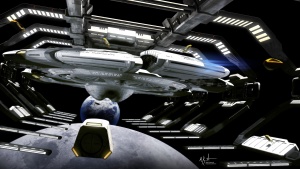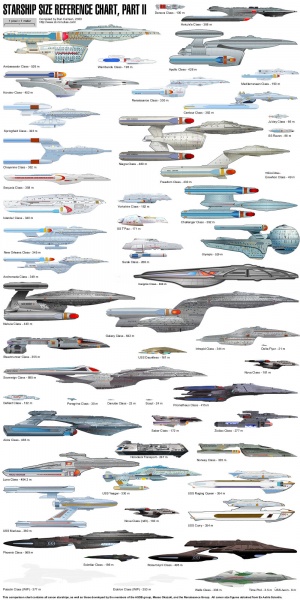More actions
JoliasEnor (talk | contribs) No edit summary |
JoliasEnor (talk | contribs) No edit summary |
||
| (8 intermediate revisions by the same user not shown) | |||
| Line 1: | Line 1: | ||
[[Image:Drydock_insignia.jpg|thumb|right|Insignia Modular Design (Large).]] | |||
The Insignia class ships were the top of the line in Starfleet's clandestine and intelligence operations on behalf of Federation Security towards the later half of the 23rd and early 24th century. | The Insignia Class was designed by Dr. Mark Kingsnorth, of the Beta Antares Fleet Yards, Antares Sector. The primary idea behind the Insignia Class design is it's modular structure which can be easily modified on short notice if necessary. This feature means the Insignia Class possesses a versatility unmatched by any other vessel currently in service within Starfleet. | ||
The Insignia class ships were the top of the line in Starfleet's clandestine and intelligence operations on behalf of Federation Security towards the later half of the 23rd and early 24th century. Intelligence favored it's modular nature which allowed for rapid prep and reaction to dynamic situations. After clandestine operations were outlawed by the treaty of Axion in 2410 the Insignia class ships started to become increasing popular for scientific and exploration intiatives as the modular design allowed for easy retrofitting for specific scientific needs with short down time. | |||
[[Image:Lunacomp.jpg|thumb|right|Size Comparison Chart (Large).]] | [[Image:Lunacomp.jpg|thumb|right|Size Comparison Chart (Large).]] | ||
===Personnel Compliment=== | ===Personnel Compliment=== | ||
*500 crew (85 Officers, 415 Enlisted Crew) | *500 crew (85 Officers, 415 Enlisted Crew) | ||
| Line 14: | Line 14: | ||
===Dimensions=== | ===Dimensions=== | ||
*Overall Length 550m | *Overall Length 550m | ||
*Overall Beam (Width) 349 m | *Overall Beam (Width) 349 m | ||
*Overall Draft (Height) 72.5 m | *Overall Draft (Height) 72.5 m | ||
*Mass: | *Mass: 2,850,000 metric tons | ||
*Decks 20 Total | *Decks 20 Total | ||
| Line 106: | Line 106: | ||
===Lateral=== | ===Lateral=== | ||
'''Number of Arrays:''' 12 | '''Number of Arrays:''' 12 | ||
Array Cluster Locations: | |||
'''Primary:''' Lateral edges of the saucer section | |||
'''Secondary:''' LORASON Sensor Pod, deck 3 Dorsal Exterior | |||
Array compositions: 6 sensor pallet clusters per array | |||
'''Pallet 1''' | |||
*Wide-angle EM radiation imaging scanner | |||
*Quark population analysis counter | |||
*Z-range particulate spectrometry sensor | |||
'''Pallet 2''' | |||
*Active magnetic interferometry scanner | |||
*High-energy proton spectrometry cluster | |||
*Gravimetric distortion mapping scanner | |||
*Isometric phase matrix imager | |||
'''Pallet 3''' | |||
*Steerable lifeform analysis instrument cluster | |||
*Pinpoint EM flux sensor | |||
*Weapons and sensor targeting scanner | |||
*ACB relay booster array | |||
'''Pallet 4''' | |||
*Low-frequency EM flux sensor | |||
*Localized subspace field stress sensor | |||
*Parametric subspace field stress sensor | |||
*Hydrogen-filter subspace flux scanner | |||
*Linear calibration subspace flux sensor | |||
'''Pallet 5''' | |||
*Variable band optical imaging cluster | |||
*Virtual aperture gravitron flux spectrometer | |||
*High-resolution graviton flux spectrometer | |||
*Very low energy graviton spin polarimeter | |||
'''Pallet 6''' | |||
*Active matrix gamma interferometry sensor | |||
*Low-level thermal imaging sensor | |||
*Multi-angle gamma frequency counter | |||
*Virtual particle mapping camera | |||
'''Other''' | |||
*Standard complement of Class I through Class IX probes | |||
*Number of sensor relay pods: 8 | |||
*Maximum range: 75 light-years | |||
==Other== | |||
===Transporter Facilities=== | |||
*Personnel Transporters: 6 | |||
*Cargo Transporters: 2 | |||
*Emergency Beam-out Transporters: 42 | |||
===Holographic Support Systems=== | |||
*3 Holodecks | |||
*Emergency Medical Holographic System Mark XV x 1 | |||
*Emergency Engineering Holographic System Mark IV x 2 | |||
*Emergency Command Holographic System Mark III x 1 | |||
===Facilities=== | |||
*10 Cargo Bays with Inter-Vessel Transporters | |||
*1 Shuttle Bays | |||
*6 Transporter Rooms | |||
*9 Emergency Transporters | |||
[[Category: Crazy Horse Page]] | [[Category: Crazy Horse Page]] | ||
Latest revision as of 11:51, 17 April 2015

The Insignia Class was designed by Dr. Mark Kingsnorth, of the Beta Antares Fleet Yards, Antares Sector. The primary idea behind the Insignia Class design is it's modular structure which can be easily modified on short notice if necessary. This feature means the Insignia Class possesses a versatility unmatched by any other vessel currently in service within Starfleet.
The Insignia class ships were the top of the line in Starfleet's clandestine and intelligence operations on behalf of Federation Security towards the later half of the 23rd and early 24th century. Intelligence favored it's modular nature which allowed for rapid prep and reaction to dynamic situations. After clandestine operations were outlawed by the treaty of Axion in 2410 the Insignia class ships started to become increasing popular for scientific and exploration intiatives as the modular design allowed for easy retrofitting for specific scientific needs with short down time.

Personnel Compliment
- 500 crew (85 Officers, 415 Enlisted Crew)
- Evacuation Limit: 8,000
Dimensions
- Overall Length 550m
- Overall Beam (Width) 349 m
- Overall Draft (Height) 72.5 m
- Mass: 2,850,000 metric tons
- Decks 20 Total
Powerplant
- Class 10 Tandem Cores (rated for combined output of 2684 Teradynes.)
- Two nacelles with 32 Warp coils.
- Four Mark-X Impulse Fusion Reactors
Performance
Warp Speeds
- Normal Cruise: Warp Factor 8
- Maximum Cruise: Warp Factor 9.5 (50 hours)
- Maximum Rated: Warp Factor 9.9 for 24-30 Hours (requires a 24 hour core restart afterward)
Impulse Speeds
- Standard Cruse: .4c
- Maximuum Speed: .7c
- 58 Total RCS Thrusters, Starfleet Standard
Armament
- 10 x Type XII Phaser Arrays
- 3 x Type XXI Pulse Fire Combination Torpedo Launchers (2 Forward, 2 Aft)
- 5 x Type XII Phaser Arrays
- 3 x Torpedo Launchers + 450 Torpedoes (2 fore / 1 aft) (150 Quantum & 300 Photon)
- 250 x Quantum Torpedoes & 300 x Photon Torpdoes
- Extra Torpedo Warheads are stored in the Armory, and Torpedo Casings can be replicated as needed.
Defenses
- Multi-Layered Shielding System, Total Capacity: 2,800,000 TeraJoules
- Heavy Duranium/Tritanium Double Hull plus 30cm of Ablative Armor (50cm in some "key" areas)
- High-Level Structural Integrity Field
Transport Equipment
- 8 x Type 9 Shuttlecraft
- 4 x Type 11 Shuttlecraft
- 2 x Argo Transport Shuttles
- 10 x Workbee Repair and Maintenance Craft
- 1 x Volga Class Runabouts
Sensor Systems
Long Range
Emitter Location: LORASON Sensor Pod, Decks 1 - 4 Dorsal Exterior Controlled from Behind Main Deflector Array, Deck 16
- High Resolution Mode Range: 24 light years (with LORASON; 7 without)
- Low Resolution Mode Range: 60 light years (with LORASON; 21 without)
Primary instruments:
- Wide-angle active EM scanner
- Narrow-angle active EM scanner
- Pinpoint active EM scanner
- 2.5 meter diameter gamma ray telescope
- Variable frequency EM flux sensor
- Lifeform analysis instrument cluster
- Parametric subspace field stress sensor
- Gravimetric distortion scanner
- Passive neutrino imaging scanner
- Thermal imaging array
- Proximity sensor array type 11-A
Number of Pallets: 3
Pallet locations
- Primary: Saucer, deck 1 Dorsal Exterior
- Secondary: Saucer, deck 12 Ventral Exterior
- Tertiary: Stardrive, deck 19 Ventral Exterior
Primary instruments:
- Quasar telescope
- -Wide-angle IR Source Tracker
- Narrow-angle IR-UV-Gamma Ray Imager
- Active subspace multibeacon receiver
- Stellar graviton detectors
- High-energy charged particle detectors
- Galactic plasma wave cartographic processor
- Federation timebase beacon receiver
- Impulse time-distortion corrector
- Stellar pair coordinate imager
Lateral
Number of Arrays: 12
Array Cluster Locations:
Primary: Lateral edges of the saucer section Secondary: LORASON Sensor Pod, deck 3 Dorsal Exterior
Array compositions: 6 sensor pallet clusters per array
Pallet 1
- Wide-angle EM radiation imaging scanner
- Quark population analysis counter
- Z-range particulate spectrometry sensor
Pallet 2
- Active magnetic interferometry scanner
- High-energy proton spectrometry cluster
- Gravimetric distortion mapping scanner
- Isometric phase matrix imager
Pallet 3
- Steerable lifeform analysis instrument cluster
- Pinpoint EM flux sensor
- Weapons and sensor targeting scanner
- ACB relay booster array
Pallet 4
- Low-frequency EM flux sensor
- Localized subspace field stress sensor
- Parametric subspace field stress sensor
- Hydrogen-filter subspace flux scanner
- Linear calibration subspace flux sensor
Pallet 5
- Variable band optical imaging cluster
- Virtual aperture gravitron flux spectrometer
- High-resolution graviton flux spectrometer
- Very low energy graviton spin polarimeter
Pallet 6
- Active matrix gamma interferometry sensor
- Low-level thermal imaging sensor
- Multi-angle gamma frequency counter
- Virtual particle mapping camera
Other
- Standard complement of Class I through Class IX probes
- Number of sensor relay pods: 8
- Maximum range: 75 light-years
Other
Transporter Facilities
- Personnel Transporters: 6
- Cargo Transporters: 2
- Emergency Beam-out Transporters: 42
Holographic Support Systems
- 3 Holodecks
- Emergency Medical Holographic System Mark XV x 1
- Emergency Engineering Holographic System Mark IV x 2
- Emergency Command Holographic System Mark III x 1
Facilities
- 10 Cargo Bays with Inter-Vessel Transporters
- 1 Shuttle Bays
- 6 Transporter Rooms
- 9 Emergency Transporters
